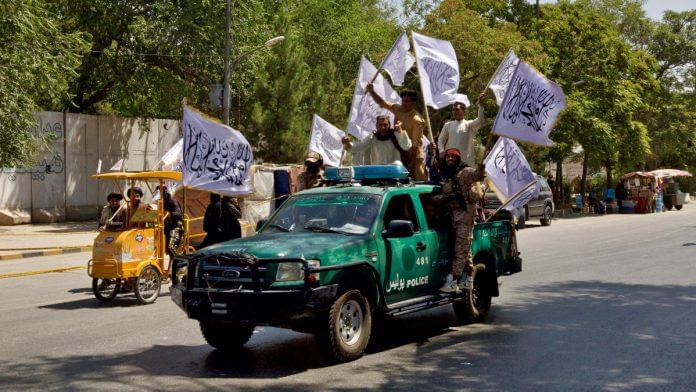Thank you dear subscribers, we are overwhelmed with your response.
Your Turn is a unique section from ThePrint featuring points of view from its subscribers. If you are a subscriber, have a point of view, please send it to us. If not, do subscribe here: https://theprint.in/subscribe/
Religio-political movements often mask raw political ambition behind moral grandstanding. Across South Asia, two forces — Hindutva and the Taliban — assert themselves as guardians of faith, culture, and morality. They claim divine mandate, national renewal, and cultural resurrection. Yet beneath the rhetoric lies a shared ethic: control of society through fear, erasure of dissent, and above all, domination over women. In both India and Afghanistan, religion is not merely a spiritual path but a weaponised instrument of power.
It is fashionable in some circles to say the Taliban and Hindutva have nothing in common. One is a militant Islamist formation rising from the debris of geopolitics; the other is a majoritarian political project wrapped in electoral legitimacy. One rules Kabul through brute force; the other rules Delhi through ballots, bureaucracy, and media capture. But peel away the method and the ideological parity is unmistakable. Both thrive on masculine supremacy, historical grievance, and mythologised civilisational hurt. Both promise a return to cultural greatness but deliver surveillance, fear, and a hierarchy where women are subordinated — by law, by custom, and by weaponised virtue.
The Taliban’s brutality is visible, dramatic, and absolute. Their erasure of girls from public life, their restrictions on education, mobility, dress, work — these are codified patriarchal decrees. Hindutva’s patriarchy is more cloaked, packaged in nationalist development rhetoric, devotional symbolism, and legalism. But the logic is eerily familiar. It seeks to confine women to “tradition,” police their sexuality, regulate marriage and inter-faith relationships, and punish autonomy as Western contamination. Where the Taliban uses the madrasa and guns, Hindutva deploys parliament, police, digital propaganda, and vigilante mobs waving the flag.
Scholars like Christophe Jaffrelot, Ayesha Jalal, and Ram Puniyani have long warned that religious nationalism and fundamentalism across South Asia are political projects, not moral crusades. Their objective is dominance, not piety. The Taliban invokes Islam not to uplift Afghan society but to enforce a militarised patriarchy. Hindutva does the same with Hinduism, not as a spiritual continuum but as an exclusive ethnic power. In both, religion is emptied of ethics and filled with authority.
The opportunism is blatant. Hindutva leaders praise women as goddesses while weaponising laws to police their wombs, marriages, and freedoms. The Taliban promises protection yet strips Afghan women of dignity and rights. Resistance by women becomes the ultimate threat to their ideology because women’s autonomy destabilises patriarchal control. Both movements fear educated women, independent women, interfaith love, feminist thought, and secular citizenship — for these disrupt hierarchy and expose the hollowness of religious supremacy.
The treatment of minorities further reveals a shared authoritarian DNA. The Taliban persecutes Hazaras, Shias, progressive Muslims, and anyone who does not conform to its hardline vision. Hindutva stigmatises Muslims, Christians, Dalits, and critical academics, branding them anti-national or foreign agents. Both deploy history selectively — glorifying mythic pasts, suppressing alternative narratives, and weaponizing memory to justify present repression. Both elevate majoritarian sentiment as destiny.
Yet the contrasts also matter. Afghanistan has been battered by foreign invasion, Cold War politics, and abandonment; its institutions were fragile long before the Taliban. India, by contrast, inherited constitutional democracy, pluralist institutions, and feminist movements that have fought hard for space. Hindutva erodes democracy from within; the Taliban rejects democracy outright. India’s slide is particularly tragic because it dismantles a modern secular promise brick by brick while claiming constitutional legitimacy.
It is therefore not enough to dismiss comparisons as false equivalence. The point is not to equate their violence but to recognise how patriarchal power mutates across political systems. When faith becomes nationalism and nationalism becomes masculinity, women become property, dissent becomes treason, and freedom becomes a threat. Whether through fatwa or digital lynch mob, the aim is the same: obedience. Whether through Sharia decree or anti-conversion law, the purpose aligns: control.
South Asia’s tragedy is that both projects emerge from insecurity masquerading as cultural assurance. The Taliban fears the world encroaching on its authoritarian Islamic fantasy. Hindutva fears an inclusive India where religion does not dictate citizenship. Both claim to protect tradition but end up imprisoning society in fear. Feminists and secular intellectuals across the region — from Indian student activists to Afghan women journalists — have shown extraordinary courage. Their struggle is not simply against religious extremism but against the political hunger that uses faith as camouflage.
We must ask: what future does South Asia deserve? One where states compete in displays of religious virility and paranoia? Or one where women walk free, minorities live without fear, and faith remains personal, not coercive? Taliban rule teaches us what happens when patriarchal militarism becomes absolute. Hindutva’s rise warns us of how swiftly democratic norms can be subverted in the name of civilisation and security. The lesson is not that India is Afghanistan. It is that authoritarian patriarchy knows many costumes — insurgent and parliamentary alike.
South Asia stands at a crossroads. Those who resist must refuse false binaries — between ballot and bullet, nationalism and faith, tradition and dignity. We must see clearly: whenever religion is deployed as state power, women lose first, minorities next, and society soon after. Liberation lies not in competing fundamentalisms but in defending the constitutional, moral, and feminist imagination that once promised this region a different destiny. History will judge our clarity and courage. Silence, denial, or exceptionalism will not save us. Only solidarity, memory, and insistence on freedom will.
*Ranjan Solomon is a political commentator and peace advocate who writes on faith, governance, and the moral questions of development.
These pieces are being published as they have been received – they have not been edited/fact-checked by ThePrint.


